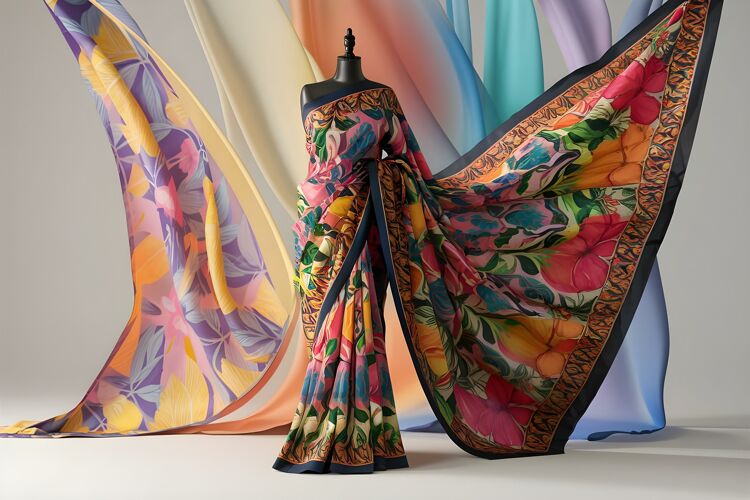How is the textile industry committed to becoming more sustainable

Debbie McKeegan discusses how the textile industry has experienced various challenges and has successfully demonstrated resilience, innovation and an unwavering commitment to sustainability.
Below we share an indication of the evolving Digital Textile Printing sector by spotlighting the predicted disruption by digital technologies, forecast machinery sales and ink market value:
Digital Textile Printing Market Overview
Digital Textile Printing Market Size was estimated at 4.26 (USD Billion) in 2022. The Digital Textile Printing Market Industry is expected to grow from 4.79 (USD Billion) in 2023 to 13.58 (USD Billion) by 2032. The Digital Textile Printing Market CAGR (growth rate) is expected to be around 12.29% during the forecast period (2024 - 2032). (Market research futures)
Digital Textile Printing Machine Market Overview
The Digital Textile Printing Machine Market Size was estimated at 2.09 (USD Billion) in 2022. The Digital Textile Printing Machine Market is expected to grow from 2.25 (USD Billion) in 2023 to 4.2 (USD Billion) by 2032. The Digital Textile Printing Machine Market CAGR (growth rate) is expected to be around 7.21% during the forecast period (2023 - 2032). (Market research futures)
The Global Digital Textile Printing Ink Market
Was valued at approximately USD 1.9 billion in 2023 and is projected to reach USD 4.2 billion by 2030, growing at a CAGR of 10.4% (Research and Markets) (Value Market Research).
And so now let’s celebrate all that we have achieved together during “A Year in Print! Below we recap just some of the standout moments and key market shifts...
We kick started the year with the excitement around the Direct-To-Film (DTF) technology. This game-changing innovation has proved an increasingly popular choice for textile companies aiming to outperform fierce competition. Known for its versatility and efficiency, DTF printing has and continues to gain ground in garment decoration for sportswear and product personalisation.
DTF also presents a cost-effective manufacturing option for the decorative textile industry – by significantly reducing ink wastage and streamlining maintenance processes. DTF printing now presents a viable, creative solution for customising sportswear and apparel textile products, whilst delivering competitive advantages to businesses within the sector. Read more here.
Smart Production and innovation were a key focus for the industry this year: Together with FESPA partners at the Print Make Wear feature in Amsterdam in 2024 we showcased smart, sustainable manufacturing. “The smart factory offers a manufacturing platform that encompasses digital technologies, print automation, and seamless workflows for on-demand production and direct customer delivery. Each element of smart production technology whether RIP software, digital print manufacturers, automation systems, or workflow management collectively crafts a seamless smart factory that operates using “one language.“ Debbie McKeegan - FESPA Textile Ambassador.
Digital textile printing also received a significant boost, with key trends and latest innovations fueling its growth. From the use of advanced pigment inks for Apparel and Décor Roll to Roll Textiles to the evolving role of automation and digitalisation, the textile printing landscape underwent a radical transformation with many manufacturers launching groundbreaking technology, redefining the contours of textile printing. “As digital textile printing continues to evolve the technology and chemistry now facilitates high speed production across multiple ink sets. These Innovations now enable pigment inks to be jetted at high speed, and the sector is set for a disruptive chapter.”
Another noteworthy development was the focus on sustainability. The textile industry took strides towards achieving carbon neutrality as digital printing began nudging textile sustainability forwards. The notion of 'green claims' also came under scrutiny, stressing on the importance of transparency and authenticity in sustainability initiatives. “Digital printing is an industry in rapid evolution, forced to adapt and innovate in the face of changing technologies, market sectors, and an ever-increasing emphasis on sustainability. The onus on the digital print industry to adopt and promote sustainable practices has never been more pressing. As it becomes a necessity rather than an option, the sourcing of certified, eco-friendly fabrics becomes both an obligation to meet environmental standards and a competitive edge in the market."
Technology-forward companies like Prinfab invited the FESPA team to visit their sustainable digital textile facility where they operate using 100% digital print machinery and have developed their own in-house software to minimise waste and reduce print failures. “Prinfab’s success rests on its technology-forward strategy. Oliver Mustoe-Playfair regards the company as much a technology entity as a textile firm. "We don’t look back. We're always looking forward," he says, indicating their focus on minimising waste and reducing print failures through their ongoing investment in latest most sustainable digital textile print machinery and software. “ Read more here.
To conclude, the year was a testament to the industry's commitment to innovation, sustainability, and continuous learning. It's been a bumpy road for many readers this year - and the future will remain a challenge for many businesses as the supply chain flexes and evolves alongside so many global influences: geopolitics, regulation, fluctuating energy, consumables, materials and shipping costs. Looking forward we can expect operational benefits and efficiencies with advancements like AI, workflow automation and seamless process and print digitalisation all paving the way to a new agile, manufacturing landscape.
We would like to thank all of our industry peers, innovators and experts who have taken the time to meet, speak and share their experience, knowledge and insights over the last year. It has been a great honor to work alongside you, and we look forward to continuing to support the industry by championing innovation and knowledge share in the year ahead.
To discover the latest content that covers a wide range of sectors including best sustainable practices sign up for FESPA’s free monthly newsletter FESPA World available in English, Spanish and German.
Topics
Recent news

What are the benefits of print businesses committing to a Net Zero Carbon emissions target?
We speak to Robert Connell, Senior Commercial Sustainability Manager at ClimatePartner who who offer solutions along the net zero cycle to support business’s effort in corporate climate action. In this discussion we discuss the importance and the process and benefits of businesses committing to a Net Zero Carbon emissions target.

6 Sustainable Printing Practices Changing the Game in Textile and Apparel Decoration
The textile industry is shifting towards sustainability. Innovations like waterless and digital printing, eco-friendly inks, and recycled materials are reducing waste. AI and automation optimise production, while circular models promote reuse. Consumer demand for transparency drives this change, making sustainable practices essential for future-focused brands.

Sustainability in Production Print: Advancing Practices in Wide Format, Textiles, and Software
As sustainability continues to take centerstage across industries, the production print sector is making massive strides in integrating eco-conscious practices. From wide format to textile applications, with the growing reliance on advanced production software, the space is evolving to meet environmental goals as well as consumer demand for sustainable products.

Why must the print industry recognise software and material innovation
Laurel Brunner argues that the printing industry must recognise the value of both software and material innovation, and be willing to pay for it. Software, though intangible, drives efficiency and reduces carbon footprints. While materials science currently dominates, R&D costs are inherent in all advancements. Paying a premium ensures continued progress, benefiting the industry's evolution and sustainability.